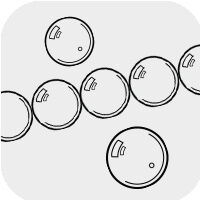Andesine Meaning and Properties
Andesine History
A fairly new gemstone shrouded in mystery, andesine is believed to have been discovered in the Democratic Republic of the Congo near the Nyiragongo Volcano sometime in 2003. The gemstone's name comes from the Andes Mountains of South America. Andesine was originally traded without disclosure of color enhancements. Much of what was originally introduced to the gemstone market as andesine is not truly andesine and is actually enhanced labradorite , a fellow plagioclase feldspar. Andesine sometimes displays a faint metallic schiller—a shimmering, reflective effect caused by light reflecting off internal layers—similar to labradorescence. Andesine properties also include a subtle pleochroism, causing the stone to show different hues when viewed from various angles.
What are the Metaphysical Properties of Andesine?
Because of its similarity to labradorite, andesine has similar metaphysical capabilities, including a transformational and restorative energy. It's also believed that andesine has abilities closely related to sunstone, including empowerment and joy. According to metaphysical beliefs, andesine is also a grounding stone that can help ease stress. While andesine isn't tied to a traditional zodiac sign, it's most often associated with Libra due to its connection with the heart chakra, balance and emotional healing.
What Chakra is Andesine?
Chakras are energy centers within the body that influence both physical and spiritual well-being. Andesine, with its warm, rosy hues, is traditionally associated with the heart chakra—the center of love, compassion and emotional healing. Andesine properties are connected to nurturing the heart, promoting emotional balance and encouraging gentle self-love. Wearing andesine bracelets allows you to carry this soothing energy throughout the day, supporting calmness, openness and a deeper connection to your feelings.
Heart Chakra (Anahata) - Green
- Location: chest (breastbone)
- Represents: the union of male and female principles; ability to love
- Emotional issues: compassion; trust; forgiveness; compassion; complex emotions; tenderness; equilibrium; love
- Spiritual issues: devotion
- Physical issues: immune system; cardio-vascular system; lungs
- Gemstones: amazonite, andesine, aventurine, jade, malachite, peridot, rhodonite, rhodochrosite, rose quartz
What is Andesine Made From?
A member of the feldspar mineral group, andesine is a plagioclase with a triclinic crystal system. All plagioclase members are a combination of albite (sodium aluminum silicate) and anorthite (calcium aluminum silicate) in varying compositions. Andesine is 50-70% albite with the remaining percentage of anorthite, while labradorite is reversed with 50-70% anorthite and the rest albite. Andesine is believed to have originated in South America and the Congo, but has also been exported from China, Mongolia, Tibet and South India. Many purported andesine specimens are actually artificially enhanced labradorite gemstones. The red hue is achieved through diffusion with copper.
- Mineral Information: Plagioclase feldspar
- Chemical Composition: (Na,Ca)Al1-2Si3-2O8
- Color: Red, green, yellow, orange, pink, multicolored
- Hardness: 6 to 6-1/2 (Mohs)
- Specific Gravity: 2.69 – 2.70
- Refractive Index: 1.560 – 1.568
How Do You Clean Andesine?
Avoid exposing andesine to extreme or prolonged heat. For this reason, boiling and similar cleaning methods are highly recommended against. Pressure can also cause andesine to crack, so it's a good idea to remove andesine jewelry before engaging in any contact sport. Andesine jewelry should also be taken off before using harsh household cleaning agents and detergents. The most effective way to clean andesine is to use a soft, clean cloth and mild soapy water. Thoroughly dry andesine and any other settings or beads in the jewelry before storing. Store andesine away from harder materials that could cause damage to the surface of the gemstone.
Andesine FAQ
Q: Is andesine a natural gemstone or is it often enhanced?
A: Although andesine is naturally occurring, it is often treated—typically through heat and copper diffusion—to enhance or produce its vivid red and green hues, which are rare in untreated stones.
Q: What causes the vivid reds, oranges and greens in andesine?
A: Trace elements of iron and copper cause the brilliant colors in andesine, however it is rare to find an untreated stone with that vibrancy. Typically, heat and copper diffusion are applied to andesine in order to draw forth its beautiful colors.
Q: Does andesine have copper in it?
A: Copper is the element responsible for the natural reddish color in rare andesine and is also the same element used in diffusion treatments to create similar hues in treated stones.
Q: What metal pairs well with andesine's unique color?
A: Gold and gold-toned metals enhance the warm reds and subtle green shimmer of andesine, while silver and silver-colored settings create a striking contrast that highlights the stone’s rich, fiery tones.
Designing with Andesine
Andesine is a great alternative to more expensive red gemstones—or it can be incorporated with red stones such as garnet and ruby for a monochromatic look. The varied colors of andesine available make it a versatile gemstone to have in your design inventory. Pair the pinkish-hued red stone with green gemstones on the complementary side of the color wheel without looking too Christmas-y. Andesine works well in both men's and women's jewelry designs.
Shop for Andesine
**Please note that all metaphysical or healing properties listed are collected from various sources. This information is offered as a service and not meant to treat medical conditions. Fire Mountain Gems and Beads® does not guarantee the validity of any of these statements.
How did you like this resource? Your feedback helps us provide resources that matter to you most.

